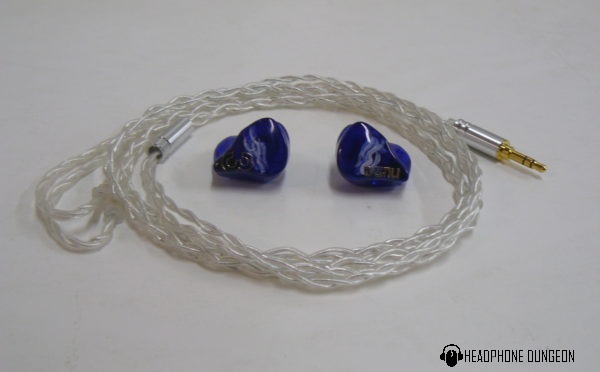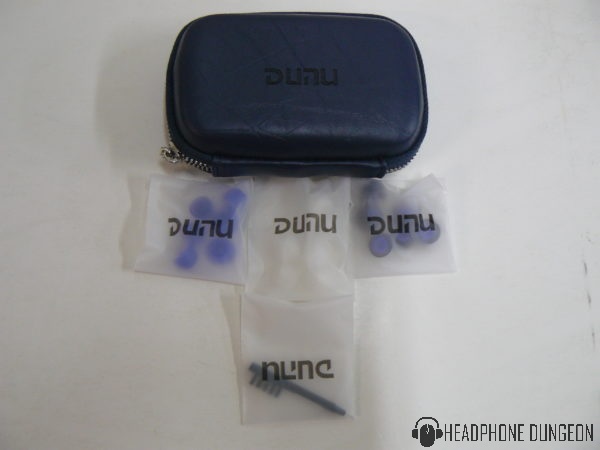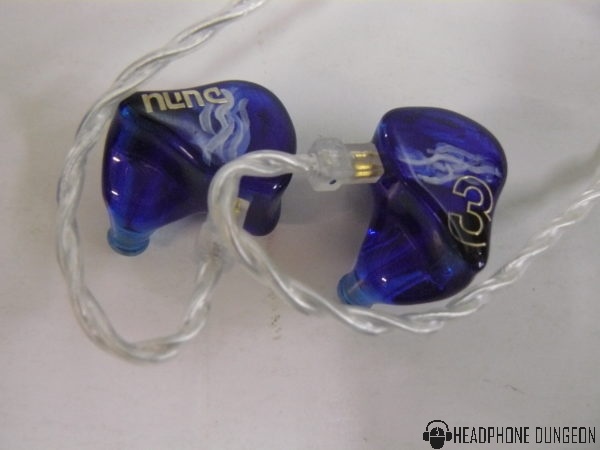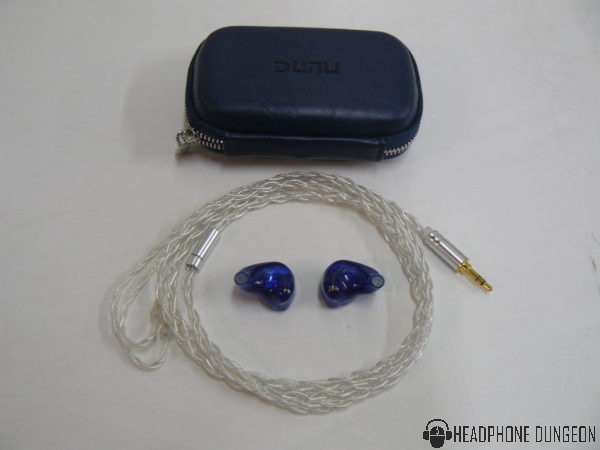
FIRST LOOK
I am a sucker for pretty things, and I think it is safe to say that most of you are too. You get exactly that from the DUNU SA3. You pop the box open to find a dark blue leather hard case, which sets the tone for the aesthetic. Very clean cut and sophisticated. As the affordable cousin of the SA6, it gave its predecessor a run for its money in terms of design. Opening the case, this notion is amplified tenfold. I’ll get to that in a second.
DUNU provides you with nine different sets of tips – three white, three bright blue and three dark blue of different sizes and material for your preference. It also comes with a handy little cleaning brush. Now, for the grand reveal. One unzips the case to find what could have easily been a mistake – these are too beautiful to be headphones. They rest in a transparent blue shell casing, which DUNU used 3-D Printing to produce. Then some major artistry comes into play with the handmade enamel designs on the faceplate that seem to resemble the sea, with golden inlays that read the model number on the left side, and the DUNU logo on the right. Finally, it is joined by a roughly 4 ft. long 2-pin 3.5 mm TRS cable.

All-around, this might be the most beautiful IEM I have seen. They really went all out on making this an attractive item, and I believe that they will sell a lot of people on that alone. So far, a $139.99 well spent. But the sound? Let’s get into it.

To start, I will put it out there that due to its low impedance of 13 ohms, it makes it a perfect fit for mobile listening. The price-point told me the same. I wanted to get a realistic application, so I plugged it into my phone. If you wish for direct reference while reading, the first song I listened to was Miracle Aligner by Arctic Monkeys.
FIRST LISTEN
Immediately I noticed something wasn’t right with this DUNU SA3. The soundstage was pretty wide at first. The strings panned outward sounded smooth and intense, but when the vocals came in, it was missing some “life” in the mix. Or rather, the essential band of frequencies around the mid-highs that really distinguishes the voice from everything else. This made sense, seeing that the Low/Mid Balanced Armature Drivers in these puppies outnumber the High Drivers 2-to-1, providing a nice backbone for the mix most of the time. If not one though, it was the other. Then, when the mix swelled, and all the instruments were playing, the high end of the orchestra and the voice clashed, and it was hard to decipher them from each other. The mid-range set the definition of the mix well, but the lows failed to really bring the mix together, thinning out at some points.
ANALYSIS
It loses that mid-high that gives voices their identity and clarity. This was improved as I increased the volume, but at the expense of my hearing? I did not find it worth it. Still, too early to dismiss. But as I continued my listening journey, I found myself thinking the same thing – although these IEMs cover the spectrum of frequencies required to listen to a song, they don’t make it all that enjoyable. It seems to lack the essential responses necessary to represent a piece of music accurately. Still, still… too early to dismiss…
WHAT I FOUND
Further listening, and rooting for these awfully pretty headphones, I needed to see if the answer lies completely in the volume. I took a risk and started really bumping it. The answer was there. The highs were too sharp, like a cut to the ear. The mid-range ran the show, with a more consistent bass response. I immediately turned lower. These have the high end, but in the wrong places. It is only engaged around the frequency range that gives you all the sharpness, without any of the sparkle or shimmering effect that high end can add to a song.
Then I tried some rap music. I found that when listening to Mac Miller’s “Cut the Check”. I got used to it and ended up bobbing my head like any other time. It was tolerable, not how it was supposed to sound though. Mostly mid.
A SECOND CHANCE
There was one more thing to try. I wasn’t giving up so easily.
I happened to have a drum mix on my phone. Finally. It made sense. The snap of that snare, the thickness on the kick… these are PERFECT for tracking drums. The cymbals missing that “life” just manages to work out, and would make it easier for a drummer to handle the constant high-end, smashing and ringing of the metal during a long recording session. This starts to hurt once you reach a certain volume though.
CONCLUSION
All-in-all, a very beautiful set of IEMs, not so much for the enjoyment of listening to music. It just didn’t hit the marks for listening that a good headphone should – accuracy, balance across volumes. There were just too many things that limit its application, all except for its response to the drums. Stunning. So are you drumming in a band? Maybe you’re a solo percussionist trying to hit the big time? If so, the DUNU Studio SA 3 are the perfect fit for you. Considering the price-to-sound ratio, for enjoyable listening I would recommend going for the lower-priced Strauss & Wagner EM205‘s, a more affordable option with about as much capability. However, if you’re looking to track drums I would highly recommend the DUNU SA3’s.
The DUNU Studio SA 3 is available at Audio 46

